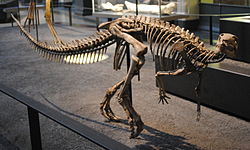| Dryosauridae Temporal range: Middle Jurassic – Early Cretaceous, | |
|---|---|
 | |
| Dysalotosaurus skeletal mount in Berlin | |
| Scientific classification | |
| Kingdom: | Animalia |
| Phylum: | Chordata |
| Class: | Reptilia |
| Clade: | Dinosauria |
| Clade: | † Ornithischia |
| Clade: | † Ornithopoda |
| Clade: | † Iguanodontia |
| Clade: | † Dryomorpha |
| Family: | † Dryosauridae Milner & Norman, 1984 [1] |
| Subgroups | |
| |
Dryosauridae is an extinct family of herbivorous bipedal ornithopod dinosaurs, first proposed by Milner & Norman in 1984. They are known from Middle Jurassic to Early Cretaceous rocks of Africa, Europe, and North America. [2] [3] [4] [5]
Dryosauridae was first proposed in 1984 by British paleontologists Andrew R. Milner and David B. Norman, as a family to unite the early ornithopods Dryosaurus , Valdosaurus , and possibly Parksosaurus and Mochlodon . Milner and Norman separated these taxa from the family Hypsilophodontidae as they showed greater similarity with hadrosaurids and iguanodontids. [1] The spelling had previously been used as a typographical error by Deraniyagala in 1939 for Dyrosauridae. [6] Dryosaurids were cursorial animals adapted for running. [7]
